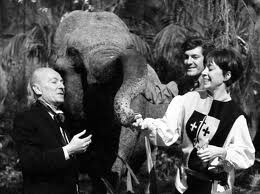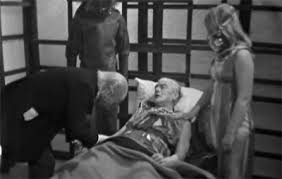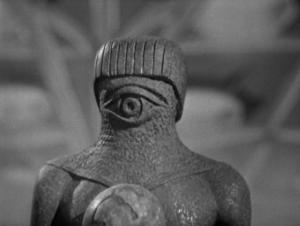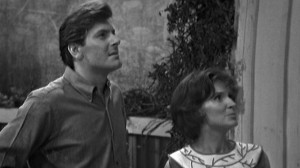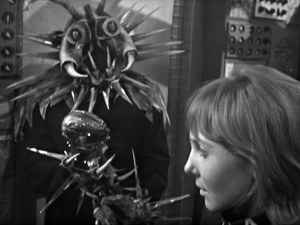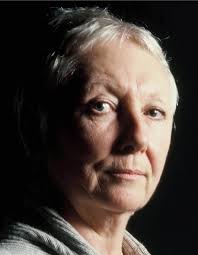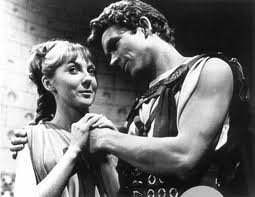
Magnificent in parts, and downright dodgy in others, The Dalek’s Master Plan was a serial of extremes. It was condemned for its violence and criticized for its comedy interludes. In Australia it was one of only two Doctor Who serials that were never screened. As parts of the 12 part serial had been classified as adult, the ABC decided against reconstructing it to fit the child friendly time slot in which Who normally aired. Viewer reaction to the Christmas special, The Feast of Steven, which was broadcast as episode 7, was particularly bad. The comedy antics in the Liverpool Police Station and the 1920’s Hollywood film set would have perplexed an audience that for the previous month and a half had been viewing a serial resplendent with fear and violence. Similarly, the unexpected arrival of the Doctor’s adversary from The Time Meddler, the Monk, in episode 8 and the comedy interludes that continued with him through episodes 9 and 10, must have been puzzling to the audience. That being said, I love the Monk and only wish he’d again grace our screens. Steven Moffatt, are you reading this?

Kert Gantry – the first of many violent deaths in The Daleks’ Master Plan
Given the length of the serial it is not my intention to provide even the most rudimentary synopsis. One transcript I’ve seen is 72 pages long and unfortunately I don’t have the time to write a 10,000 word dissertation! There are a number of books that provide excellent summaries of this, and other, Who serials. In particular I’d suggest David J Howe and Stephen James Walker’s The Television Companion. The Unofficial and Unauthorised Guide to Doctor Who. Published by Telos in 2003 the book is now out of print although copies frequently appear on eBay. Telos Publishing uploaded cover photos of Volume 1 and 2 of the 2013 edition of The Television Companion on their Facebook page in late 2012. I’m uncertain when the release is anticipated.

David J Howe & Stephen James Walker’s The Television Companion was published in 2003 by Telos Publishing
The death of real humans, and not the “Bug Eyed Monsters” that Sydney Newman so decried, was a permeating feature of The Daleks’ Master Plan. The deaths of three Tardis travellers, companions Katarina and Sara Kingdom, and Space Security Service agent Bret Vyon, upended all hitherto held presumptions that the Doctor always averted disaster. Unlike any Who serial that it had preceded in respect of violence, The Daleks’ Master Plan evidenced the new tangent that producer, John Wiles, was taking the show. It is to the lives and deaths of these three Tardis fellow travellers that I will be devoting today’s review.

Vyon, the Doctor, Katarina and Steven
KATARINA
Katarina, the deferential handmaiden of Cassandra, was a sudden and unwitting occupant of the Tardis as the credits rolled in The Myth Makers. Pushed into the Ship by the departing Vicki, Katarina was clearly out of her depth in a world of space travel. Possibly born as early as 1300 BC, Katarina’s fellow passenger was the space pilot Steven, whose era of birth was never stated but was probably born sometime after 2500 AD. With around four millennia separating their births, Steven and Katarina would have been as alien to each other as the Doctor was to Barbara and Ian when first they met in the scrap merchant’s yard at Totters Lane. Katarina was a women of her time and naturally observed and comprehended all around her in the context of a mystical or supernatural schema. Once in the Tardis she believed she had entered the hereafter and that the Doctor was her gateway to the Place of Perfection. She spoke barely a word during her full three episodes as a member of the Tardis Crew, and took no active part in any of the proceedings, save for operating some buttons on the console as directed by the Doctor and retrieving tablets from Bret Vyon’s pocket.

Katarina
The object of the third episode cliff hanger, Katarina was taken hostage at knifepoint by a prisoner, Kirksen, who had boarded the Doctor’s stolen spacecraft after it had crash landed on the prison planet, Desperus. Unaware that Kirksen was onboard and hiding in the airlock, the spacecraft took off again after hasty repairs. Kirksen threatened to kill Katarina if he was not returned to the nearest planet, which inconveniently for the Doctor and crew was the very planet from which they’d just escaped, Kembel. Heated debate ensued between the Doctor, Steven and Bret Vyon as to whether they should turn back. Although a decision was eventually made to return to Kembel, Katarina pushed a button which opened the airlock door. She and Kirksen are sucked into space and died, and all within the first five minutes of episode four. Although Steven thought that this may have been an accident, the Doctor was convinced that she had sacrificed her life for them. He lamented her demise whilst congratulating her courage:

Katarina tends the gravely ill Steven
“She didn’t understand. She couldn’t understand. She wanted to save our lives and perhaps the lives of all the other beings of the Solar System. I hope she’s found her Perfection. Oh, how I shall always remember her as one of the Daughters of the Gods. Yes, as one of the Daughters of the Gods”.

Katarina is taken captive by Kirksen
Katarina’s shocking death was the first to befall a companion in Doctor Who and was yet another in an increasingly long string of failures for the Doctor.

Steven and Katarina
BRET VYON
It is perhaps because Nicholas Courtney went on to become the much cherished Brigadier Alistair Gordon Lethbridge-Stewart, that the first character he played in Doctor Who, Bret Vyon, has not been accorded the status of companion in the annals of Who history. Spending as much time onscreen and inside the Tardis as the official companion Katarina, Vyon’s character has been viewed somewhat as an interloper, albeit one with an incredibly extensive role in episodes one through to four. Unlike the almost mute Katarina who was almost entirely compliant with the Doctor’s commands, Vyon was headstrong and self assured, and began his relationship with the Doctor on less than civil terms. On the planet Kembel with fellow agent Kert Gantry, Vyon was looking for leads on the fate of Marc Cory, the agent who met his demise at the Daleks’ hands in Mission to the Unknown. Gantry was quickly and violently dispatched by the Daleks within minutes of the opening of episode one, leaving Vyon alone in the jungle. Finding the Doctor outside of the Tardis, Vyon threatens him at gunpoint and demands the key. “Give me the key or I’ll kill you” he states. Leaving the Doctor outside, Vyon enters the Tardis and is confronted by Katarina and Steven, who is only in a semi-conscious state following the injuries sustained at the end of The Myth Makers. Vyon demands that the crew fly the Ship, together with him, off the planet. Rousing briefly in a groggy state, Steven uses a spanner and knocks out Vyon who falls to the floor.

Nicholas Courtney played Bret Vyon in his first Doctor Who appearance
The Doctor soon enters the Tardis and puts the unconscious Vyon into chair. Upon the disorientated Vyon waking up the Doctor says to him, “I call it the magnetic chair. It has a forcefield strong enough to restrain a herd of elephants”. After the Doctor leaves, Vyon assists Steven by guiding Katarina to remove two tablets from his pocket. The naive Katarina has never seen tablets before and has to ask Vyon if what she’s found is indeed them. By assisting in Steven’s recovery Vyon, whom the Doctor had earlier considered to be a “violent young man”, showed himself to be an ally of the Tardis Crew. Released from the restraint of the chair, Vyon thereafter works in coalition with the Doctor.
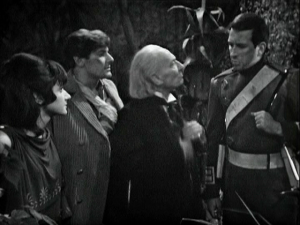
Katarina, Steven, the Doctor and Vyon
Again displaying his propensity for violence, Vyon commandeers Mavic Chen, the Guardian of the Solar System’s, Spar which for all intents and purposes is a hotted up spaceship. After sneaking into the ship and taking the pilot and engineer by surprise, Vyon shouts “I’m taking over this spaceship. Over there. Tie them up”. With just Steven and Katarina present during the heist, Vyon almost takes off without the Doctor after being shocked by the sound of an alarm. Luckily the Doctor returns just prior to take-off. After the death of Katarina along the way, the eventually arrive at Earth where Vyon meets up with an old friend, Daxtar, the manager of a research station. Vyon believes that Daxtar will become an ally against the Daleks’ and Mavic Chen’s plans for domination of the universe. Unknown to Vyon, Chen has already procured Daxtar’s allegiances. The Doctor quickly twigs to this betrayal upon Daxtar mentioning the taranium core, something which Daxtar could only be aware of if he was in league with the enemy. Without a second’s delay Vyon shoots Daxtar dead. Before there’s any chance to contemplate the consequences of Vyon’s actions, the group is scattered by the arrival of Space Security Agent Sara Kingdom and her colleague, Borkar. Sent by Chen to assassinate the “traitors” who had stolen the Taranium core, Kingdom shoots Vyon dead. It is only later that we become privy to the fact that Kingdom is Vyon’s sister.

Vyon and Steven
SARA KINGDOM
Like Vyon, Sara Kingdom is an employee of the Space Security Service. The SSS is at the service of Mavic Chen, the Guardian of the Solar System and perhaps one of Doctor Who’s most evil villains ever. Highly regarded by the Service, Kingdom is known to obey orders without question in a ruthless and timely manner. It is with these credentials in mind that Chen dispatched Kingdom to seek and destroy the Doctor, Steven, and Vyon. Our hero, the Doctor, had masqueraded as Zephon, one of the delegates to the Dalek’s conference, and attended the meeting in which Chen had advised that the Daleks’ ultimate weapon, the Time Destructor, was complete. The real Zephon, however, had been tied up by Katarina and Steven at Vyon’s command. Upon Zephon freeing himself and activating an alarm, the Daleks’ conference went into a state of chaos and the Doctor was able to escape with the Taranium Core, the essential element required to activate the Time Destructor. It was because the Doctor and his crew had the Taranium Core that Mavic wanted them dead and the Core returned to him.

Jean Marsh in black cat suit as Sara Kingdom
Unlike her brother Vyon, Kingdom is not yet cognisant of Chen’s treachery and assumes that he is working in the best interests of the Solar System. She immediately accepts Chen’s command and quickly dispatches Vyon with seemingly no remorse. Kingdom is portrayed as a cold blooded killer and orders her colleague, Borkar, to track down and kill the Doctor and Steven. After chasing the Doctor and Steven, Kingdom is caught with them in a laboratory. Whilst there they are accidently subjected to a molecular dissemination experiment (together with some mice, but that’s another story) and transported to the planet Mira. Confronted by invisible monsters named Visians, the Doctor, Kingdom and Steven retreat into a cave. Steven argues with Kingdom about Vyon’s death and accuses her of blindly following Chen’s orders without question. Had she not considered, Steven posited, why a space security agent, one of her own people, had become a traitor? She questioned neither Chen nor Vyon, and didn’t give Vyon a chance. Considering Steven’s story fantastic Kingdom eventually admits that Vyon was her brother and rushes out of the cave in a distraught manner. The Doctor takes this as a sign that Kingdom finally believes them. Shortly thereafter Kingdom returns to the cave after being touched by a Visian. From that point forward Kingdom is a firm ally of the Doctor and Steven.

Sara Kingdom in combat mode
Kingdom is adept at martial arts and karate chops several villains in the course of our heroes’ adventures. Unfortunately those episodes are lost in time so viewers are unlikely to ever see the black cat suited Kingdom doing her moves on our TV screens. She eventually loses her life in episode 12 after going back into the Daleks’ underground city to assist the Doctor. The Doctor activates the Time Destructor after the distraction caused by Chen’s execution, and he and Kingdom make their way back to the Tardis. Steven is already safely ensconced within, having previously been ordered back to the Ship by the Doctor. In the process of returning to the Tardis through the jungle the Doctor and Kingdom begin to rapidly age. Having both collapsed, Kingdom dies, is reduced to bones and quickly thereafter, dust. Presumably because of his Time Lord anatomy (although, of course, he was not yet identified as such in the series) the Doctor does not age as rapidly as Kingdom. Seeing the pair on the scanner, Steven rushes outside and also begins to age. In attempting to deactivate the Time Destructor Steven accidently puts it in reverse resulting in our two heroes returning to the correct ages. Being already dead, it is too late for Kingdom and also for the Daleks, who had until that point been seemingly immune to the effects of the Time Destructor. More about the fate of the Daleks, however, in my next review.

Sara Kingdom ages from the effects of the Time Destructor
As an aside, there’s a rather nice interview with Jean Marsh, who played Sara Kingdom, in the special features of the Seventh Doctor’s Battlefield DVD. In the segment entitled From Kingdom to Queen, Marsh reminisces on her three appearances in Doctor Who – The Crusade (1965), The Daleks’ Master Plan (1965/6) and Battlefield (1989). Although not referred to in the interview, it’s interesting to note that Marsh appeared with Nicholas Courtney in both his first (The Daleks’ Master Plan) and last (Battlefield) appearance on Doctor Who. That makes the world of Who seem very small and incestuous, doesn’t it?

Sara Kingdom collapses as she rapidly ages
Stay tuned for my next review on three of the villains in The Daleks’ Master Plan – Mavic Chen, the Daleks, and the Monk.
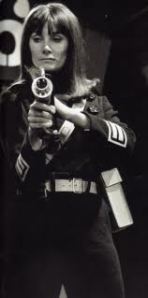
The young Sara Kingdom

An interview with Jean Marsh, From Kingdom to Queen, is one of the special features of the Seventh Doctor’s Battlefield DVD

Episodes 2, 5 and 10 of The Daleks’ Master Plan are included in the Lost in Time triple DVD set. The Daleks’ Master Plan was originally broadcast in the UK between 13th November 1965 and 29 January 1966.
Vivien Fleming
©Vivien Fleming, 2013.
Reference
David J Howe & Stephen James Walker, The Television Companion. The Unofficial and Unauthorised Guide to Doctor Who. Telos Publishing Ltd, Surrey, 2003.













